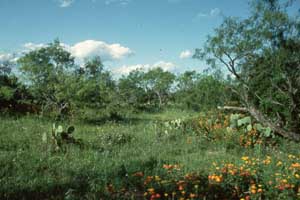- The State of the Gulf of Mexico (July 2008)
- The State of Lakes (July 2007)
- The State of Wetlands (July 2006)
- The State of Springs (July 2005)
- The State of Rivers (July 2004)
- The State of Bays (July 2003)
- The State of Water (July 2002)

The State of Water in the South Texas Brush Country

This border area is experiencing one of the highest rates of population growth in the state, causing increasing demands on an already limited water supply.
Major Water Challenge: Restoring water flows in the Rio Grande. Waterflow decreased enough recently that the Rio Grande stopped flowing to the Gulf of Mexico. Workers with shovels opened a path to restore the flow to the Gulf.
Water Resource Problems: By 2050, population is expected to more than double; the Lower Rio Grande Valley is expected to grow 175%.
This region stretches south from the edges of the Hill Country and San Antonio through brush and mesquite plains, dotted with deep bluewater lakes, into the subtropical environment of the lower Rio Grande.
In the dense brush of the mustang plains, Mexican vaqueros developed the tools and skills for herding wild Texas longhorns, giving birth to the cattle industry and that greatest of American heroes – the cowboy. Historic sites such as Casa Navarro in San Antonio, the restored mission at Goliad and Fannin Battleground recall early Spanish and Mexican culture and Texas' struggle for independence. Choke Canyon and Falcon offer wonderful water recreation to winter vacationers and Bentsen-Rio Grande Valley is a subtropical gem replete with birds and other animal life found nowhere else in the U.S.
The South Texas Brush Country is characterized by plains of thorny shrubs and trees and scattered patches of palms and subtropical woodlands in the Rio Grande Valley. The plains were once covered with open grasslands and a scattering of trees, and the valley woodlands were once more extensive. Today, the primary vegetation consists of thorny brush such as mesquite, acacia, and prickly pear mixed with areas of grassland. The average annual rainfall of 20 to 32 inches increases from west to east.
Sand sheet wetlands are small isolated depressions. They are found in places where wind exposes clay soils that trap and hold rainwater. These depressions often provide the only fresh water for wildlife in a normally dry environment.
Resacas are former channels of the Rio Grande River that have been cut off from the river and filled with silt and water creating marshes and ponds.
Because most sand sheet wetlands and resacas are ephemeral (short-lived), the plants and wildlife using them vary seasonally depending on the quantity and quality of the available water.
Although many land changes have occurred in this region, the Brush Country remains rich in wildlife and a haven for many rare species of plants and animals. It is home for semi-tropical species that occur in Mexico, grassland species that range northward, and desert species commonly found in the Trans-Pecos.
Water Supply and Demand
Supply
Major Rivers: Guadalupe, San Antonio, Nueces, Lavaca, Rio
Grande
Major Aquifer: Edwards, Trinity, Carrizo-Wilcox, Gulf Coast
Use & Demand
San Antonio/Northern area:
- 76% demand met through groundwater, 50% demand is for irrigation, 33% municipal.
- By 2050, the population of the area is expected to more than double. The demand for water is expected to change to 47% for municipal and 30% for irrigation.
- Water management plans require that less water is to pumped from Edwards Aquifer, and the need to rely more heavily on surface water in the future.
Lower Rio Grande Valley:
- 98% demand met through surface water,87% used for irrigation, 12% municipal.
- By 2050, population is expected to grow 175%. Demand expected to change to 69% irrigation and 30% municipal.
- Surface water rights are appropriated in the valley. (Source: Texas Center for Policy Studies. Texas Environmental Almanac (Austin: U.T. Press, 2002), 27-29.)
Major Cities - Rainfall / Elevation
Regional Average Rainfall: 20-32 inches per year
Regional Average Net Evaporation rate: 16-28 inches
The average annual rainfall of 20 to 32 inches increases from west to east.
Average monthly rainfall is lowest during winter, and highest during spring
(May or June) and fall (September). Summer temperatures are high, with very
high evaporation rates. Data source: National Climate Datat Center, U.S. Dept of Commerce.
Brownsville - 27.55 in / 19 ft
Crystal City - 20.70 in / 580 ft
Eagle Pass - 21.48 in / 808 ft
Falfurrias - 25.42 in / 120 ft
Goliad - 38.58 in / 142 ft
Laredo - 21.53 in / 430 ft
Pearsall - 25.73 in / 635 ft
Poteet - 29.00 in / 480 ft
Rio Grande City - 21.61 in/ 172 ft
San Antonio 32.92 in / 809 ft
Zapata - 19.72 in / 311 ft